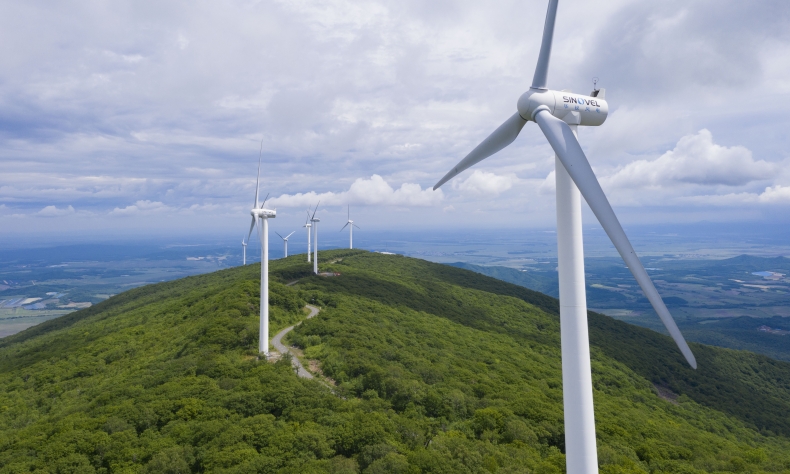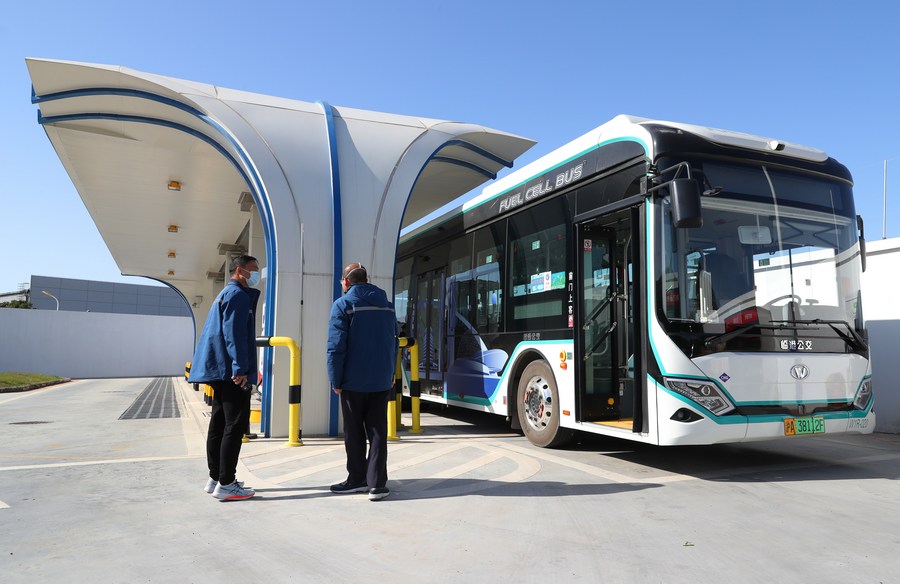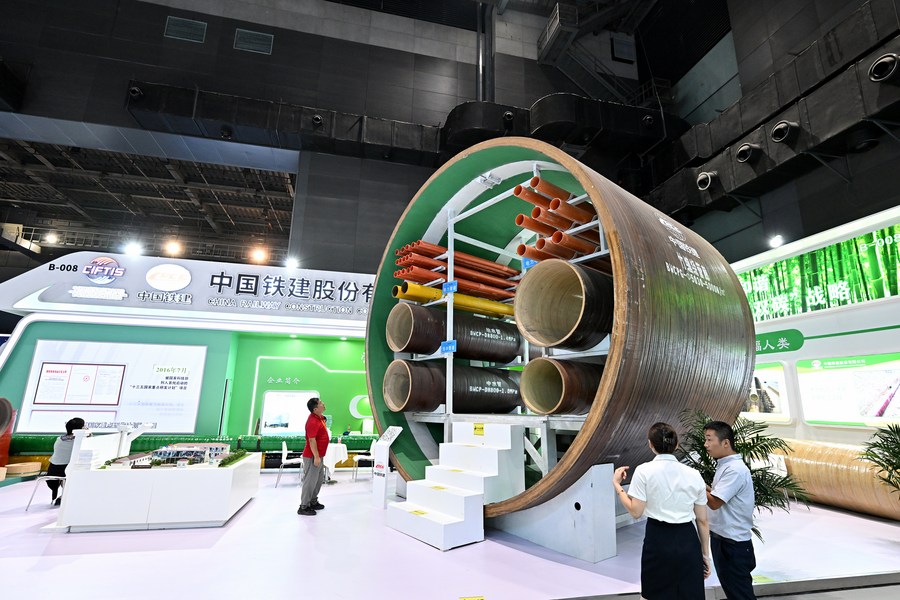Zeroing in on Zero

Companies in the U.K. and China join hands to achieve the two countries’ net zero targets.
When Chinese President Xi Jinping announced China’s dual carbon goals – peaking carbon emissions before 2030 and achieving carbon neutrality by 2060 – at the UN General Assembly in 2020, it created a synergy with the U.K., which aims to bring all greenhouse gas emissions to net zero by 2050.
With clean energy and low-carbon development becoming an international trend, China and the U.K. are leveraging their respective strengths to deepen cooperation in these areas, which will not only benefit both countries, but also promote an effective global response to climate change.
Hydrogen development roadmap
At the third International Hydrogen Ecosystem Annual Conference held during the 2023 China International Fair for Trade in Services (CIFTIS) in Beijing, David Giles, head of energy transition and integration at the Department for Business and Trade at the British Embassy in Beijing, described the U.K.’s vision and roadmap for hydrogen development. He also detailed Britain’s hydrogen economy, investment prospects, opportunities and potential cooperation with China.
The U.K. government announced its hydrogen strategy in 2021, making hydrogen energy an important component of the country’s new energy industry cluster. China also saw an explosive growth in its hydrogen energy industry in 2022. In the same year, the National Development and Reform Commission of China released a medium- and long-term plan for the development of China’s hydrogen energy industry (2021-2035), officially including hydrogen energy in the national energy development strategy.
“The U.K. and China are highly complementary in (developing) hydrogen fuel-cell vehicles, and that lays a solid foundation for our cooperation,” Giles said. He told China Today that the U.K. has already formed a relatively complete industrial chain made up by over 100 enterprises and 40 R&D institutions thanks to the country’s early foray into the sector. In China, the market is huge, and a raft of supportive government policies have been put in place. In 2021, three Chinese mega-city clusters – the Beijing-Tianjin-Hebei region, the Yangtze River Delta region, and the Greater Bay Area – were approved as the first batch of demonstrative urban clusters for hydrogen fuel-cell vehicles, boosting a new stage of rapid development.
The industry is witnessing British companies entering China and vice versa. In 2019, Chinese carmaker Chang’an New Energy established an innovation center in Birmingham. It develops full power fuel-cell vehicles in collaboration with Intelligent Energy, a U.K.-based hydrogen fuel cell manufacturer.
Johnson Matthey, headquartered in London, is a global chemical company, specializing in catalysts, catalyst coated membranes, and membrane electrode assembly (MEA) used in fuel cells. In 2020, Johnson Matthey built an MEA factory in Shanghai with an annual production capacity of four million pieces, which can produce power for over 10,000 buses and commercial vehicles.
“Striving for an economic growth driven by hydrogen energy is crucial for the U.K. and China to achieve their net zero and carbon neutrality goals,” Giles said. The long industrial chain of hydrogen energy also needs bilateral collaboration at the upstream and downstream of the industrial chain, so as to reduce costs significantly. The rapid development of the hydrogen energy industry will boost global employment and economic growth, reduce carbon dioxide emissions, and safeguard national energy security, he noted.

Setting green standards
For the net zero goal, setting green standards is also a major objective in China-U.K. collaboration. At the 2023 CIFTIS, Giles hosted a workshop on “Net Zero Best Practice Sharing,” where leading British companies shared the latest trends and their experience in green finance, net-zero buildings, and energy transition.
“Many British companies have rich experience and expertise in the low-carbon field, involving standard settings, design planning, and asset operation. They have been involved in China’s decarbonization efforts with their Chinese partners for years, such as the BRE Group, Savills and ZEDFactory,” Giles said. He particularly mentioned the Carbon Trust, a low-carbon consulting firm headquartered in the U.K.
According to Zhao Lijian, director of the Carbon Trust’s China office, in 2007, the firm launched the world’s first carbon footprint label verification standard, the Publicly Available Specification (PAS) 2050, which assesses the greenhouse gas emissions of goods and services during their entire lifecycle. Based on the standard, a label indicating verified carbon footprints is put on product packaging.
“Carbon labels display the carbon footprints of a product throughout its entire life cycle. As a comprehensive and scientific way of evaluating products’ carbon emissions, it helps governments, enterprises, and consumers get information on the products’ carbon emissions,” Zhao said.
Nearly 30,000 types of products in over 40 countries and regions bear the Carbon Trust’s carbon labels, including brands such as Nestlé, LG, Dyson, Tetra Pak and Kia Motors. Zhao said the Amazon e-commerce platform is also using their carbon labels to promote green consumption behavior among the public.
The Carbon Trust launched its carbon certification business in China in early 2022, receiving a positive response from many enterprises. The certification and corresponding carbon label is given to enterprises after their products meet Carbon Trust’s verification standards.
Zhao said this promotes a green supply chain. More companies will purchase low-carbon or carbon-neutral products, and partner with companies that are also aware of carbon reduction, thereby reducing the carbon emissions of the entire value chain of products.
“It is a win-win initiative,” he said.
Enterprises can showcase their carbon reduction achievements through the labels, responding to the policies at home and abroad, such as the EU’s plan to impose carbon tariffs. Low carbon is becoming a major feature of responsible enterprises, enhancing their international competitiveness. Aware consumers make their purchase decisions based on the products’ carbon emission information printed on the carbon labels. Leading British market research company YouGov found in its global survey in 2022 that 62 percent of Chinese consumers tend to purchase products with carbon labels.
Tom Delay, CEO of the Carbon Trust, said achieving carbon neutrality is not an easy task, but challenges also mean opportunities. “We note that green finance is playing an increasingly important role in the Chinese market,” he added.

Financing for green technologies
Green technologies play a crucial role in supporting economic transformation and high-quality development. Zhao said China, with its strong production capacity and sound industrial network, is a global leader in green technologies. However, the lack of unified evaluation standards hinders financial institutions beyond Asia from investing and developing in China. The Carbon Trust plans to introduce more financial investment resources with carbon reduction technologies to Chinese enterprises to facilitate the national strategy of carbon neutrality and boost green transition and growth with technology innovation.
The Green Technology Selector (GTS) is an online platform developed by the European Bank for Reconstruction and Development (EBRD) to screen advanced green technology products worldwide. In 2020, the Carbon Trust collaborated with the EBRD to promote the GTS in the Chinese market. To obtain loans, all listed technologies must meet the minimum technical standards set by the EBRD, ensuring that they are environmentally friendly and using less energy and water compared to similar technologies on the market. Products and manufacturers registered on this platform are recognized as produced with first-class green technologies and receive global promotion.
At present, more than 2,500 types of products from over 150 Chinese manufacturers have been registered on the GTS, involving multiple industries. Solar photovoltaic products have the lion’s share, followed by products of mechanical processing, lighting, pumps, household appli-ances, vehicles, and land preparation and seeding technology.
“This project is an excellent case of multi-party cooperation. Technology providers, financial institutions, and small and medium-sized enterprises (SMEs) all benefit from the GTS,” Zhao said. “It can help SMEs obtain affordable green technologies and domestic enterprises improve their international visibility with more financing for low-carbon transition via multilateral development banks and local financial institutions.”
Giles listed more cooperation priorities between China and the U.K., including floating offshore wind power, low-carbon hydrogen, carbon capture, utilization and storage (CCUS), civilian nuclear energy, and low-carbon urban construction. “Fostering energy transition is a global consensus and an economic reality that the British and Chinese partners spanning from governments to financial institutions and technology companies are working on together,” he said.
He shared the example of two memorandums of understanding on hydrogen energy cooperation signed between the U.K. and China in April 2022. One was between Manchester and Wuhan and the other between Manchester Metropolitan University and Wuhan University of Technology. In addition, the U.K.-China (Guangdong) CCUS Center has been set up to support the use of CCUS technologies. Based on it, British oil and gas giants Shell and BP have been collaborating with Chinese institutions, aiming for broader partnerships on the green supply chain in future.
 Facebook
Facebook
 Twitter
Twitter
 Linkedin
Linkedin
 Google +
Google +










